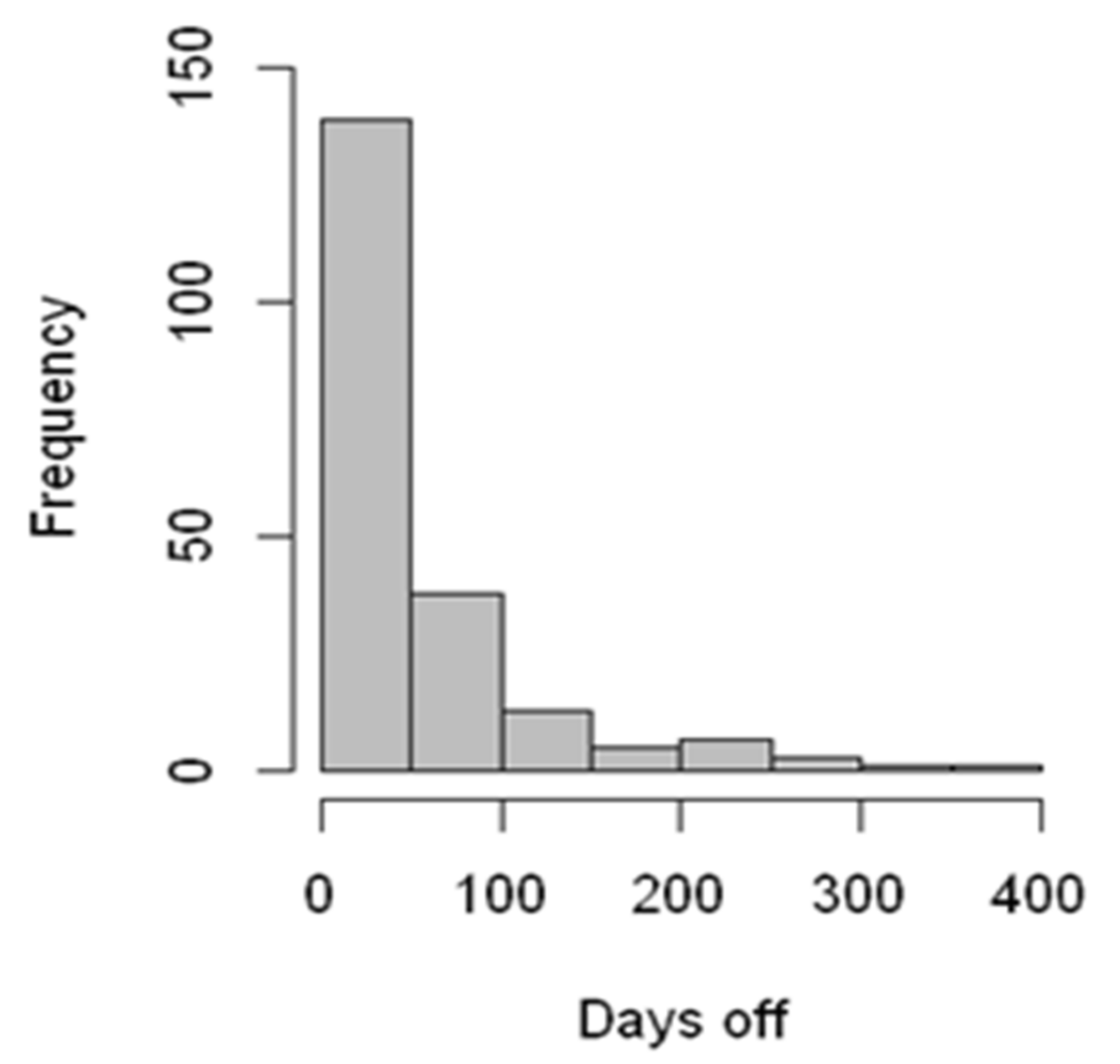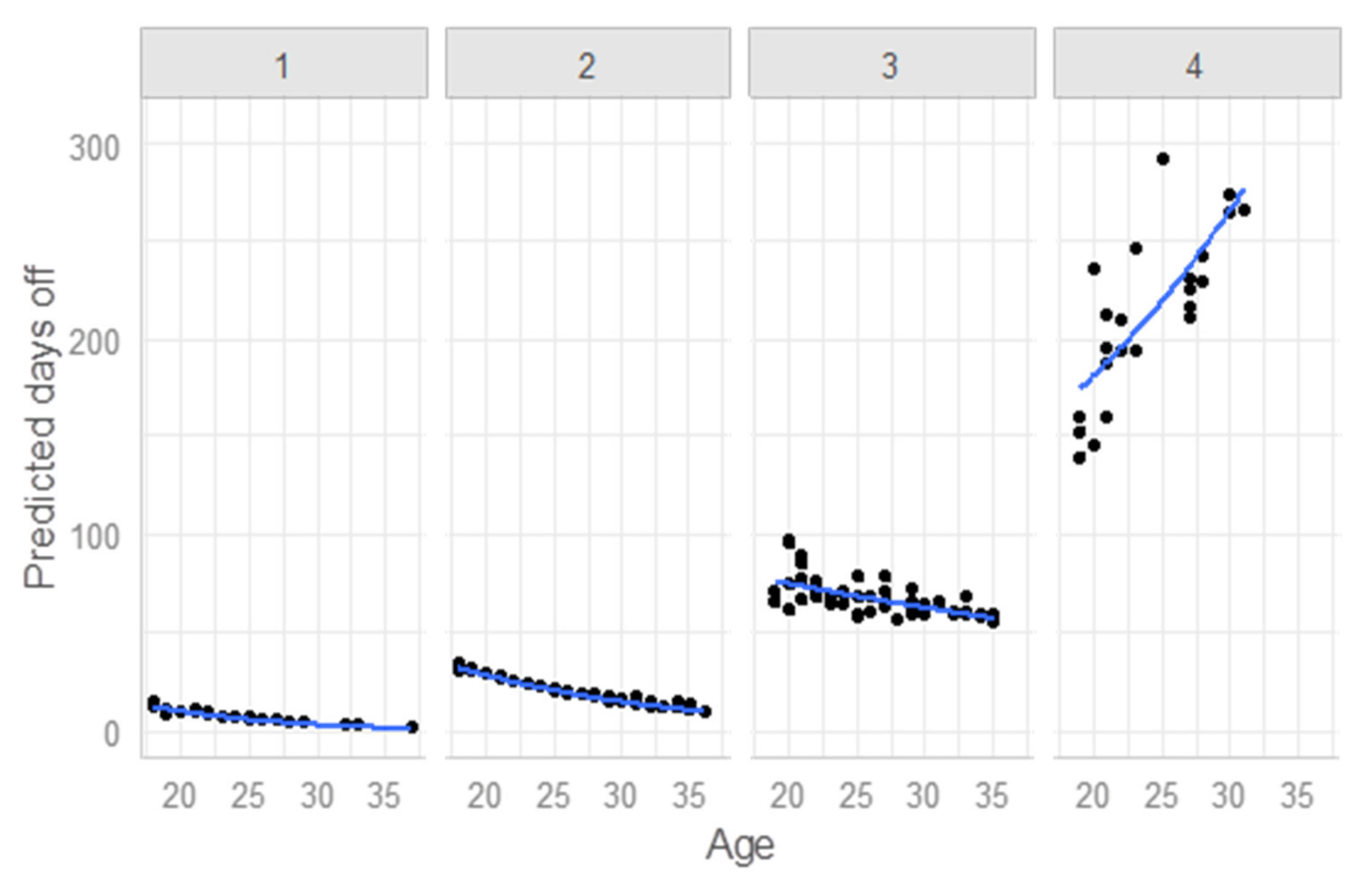Dispositional Mindfulness and Injury Time Loss in Soccer
Abstract
:1. Introduction
2. Materials and Methods
2.1. Participants and Measures
- Injury Severity. Participants were asked about their last injury. Injury severity was quantified according with professional criteria to describe soccer injuries and specific treatment [17]. There were four main categories of injury severity: mild (requiring treatment but training is uninterrupted), moderate (requiring treatment and interrupting training and competition), serious (up to two months off, sometimes hospitalization/surgery), and very serious (meaningful impairment in performance, requiring constant rehabilitation).
- Mindfulness. Dispositional mindfulness was evaluated with the Mindfulness Inventory for Sport [18], a 15-item instrument answered on a six-point Likert-type format from one (not at all), to six (very much). There are three 5-item subscales, awareness, non-judgmental, and refocusing, even though a global score of dispositional mindfulness was used here. Higher scores indicated a higher level in dispositional mindfulness. The Cronbach’s alpha reliability for the current data was 0.66. The dispositional mindfulness was chosen as a way to have an exact idea of the ability of being mindful of the athletes in the moment of the study.
- Length of recovery. The length of recovery from an injury was computed with the days off reported by each participant concerning the last injury.
2.2. Procedure
2.3. Statistical Analyses
3. Results
4. Discussion
Author Contributions
Funding
Institutional Review Board Statement
Informed Consent Statement
Data Availability Statement
Acknowledgments
Conflicts of Interest
References
- Hägglund, M.; Walden, M.; Magnusson, H.; Kristenson, K.; Bengtsson, H.; Ekstrand, J. Injuries affect team performance negatively in professional football: An 11–17 year follow-up of the UEFA Champions League injury study. Br. J. Sports Med. 2016, 47, 738–742. [Google Scholar] [CrossRef] [PubMed] [Green Version]
- Wiese-Bjornstal, D.M.; Smith, A.M.; Shaffer, S.M.; Morrey, M.A. An Integrated Model of response to sport injury: Psychological and sociological dynamics. J. Appl. Sport Psychol. 1998, 10, 46–69. [Google Scholar] [CrossRef] [Green Version]
- Williams, J.M.; Andersen, M.B. Psychosocial antecedents of sport injury: Review 20 and critique of the stress and injury model. J. Appl. Sport Psychol. 1998, 10, 5–25. [Google Scholar] [CrossRef]
- Devantier, C. Psychological predictors of injury among professional soccer players. Sport Sci. Rev. 2011, 20, 5–36. [Google Scholar] [CrossRef]
- Ivarsson, A.; Johnson, U.; Andersen, M.B.; Tranaeus, U.; Stenling, A.; Lindwall, M. Psychosocial factors and sport injuries: Meta-analyses for prediction and prevention. Sports Med. 2017, 47, 353–365. [Google Scholar] [CrossRef] [PubMed]
- Birrer, D.; Röthlin, P.; Morgan, G. Mindfulness to enhance athletic performance: Theoretical considerations and possible impact mechanisms. Mindfulness 2012, 3, 235–246. [Google Scholar] [CrossRef]
- Kabat-Zinn, J. Full Catastrophe Living: Using the Wisdom of Your Body and Mind to Face Stress, Pain, and Illness; Dell Publishing: New York, NY, USA, 1990. [Google Scholar]
- Noetel, M.; Ciarrochi, J.; Van Zanden, B.; Londsdale, C. Mindfulness and acceptance approaches to sporting performance enhancement: A systematic review. Int. Rev. Sport Exerc. Psychol. 2017, 12, 1–37. [Google Scholar] [CrossRef]
- Bühlmayer, L.; Birrer, D.; Rothlin, P.; Faude, O.; Donath, L. Effects of Mindfulness Practice on Performance-Relevant Parameters and Performance Outcomes in Sports: A Meta-Analytical Review. Sports Med. 2017, 47, 2309–2321. [Google Scholar] [CrossRef] [PubMed]
- Holguín-Ramírez, J.; Ramos-Jiménez, A.; Quezada-Chacón, J.T.; Cervantes-Borunda, M.S.; Hernández-Torres, R.P. Effect of Mindfulness on the Stress-Recovery Balance in Professional Soccer Players during the Competitive Season. Sustainability 2020, 12, 7091. [Google Scholar] [CrossRef]
- Ivarsson, A.; Johnson, U.; Andersen, M.B.; Fallby, J.; Altemyr, M. It pays to pay attention: A mindfulness-based program for injury prevention with soccer players. J. Appl. Sport Psychol. 2015, 27, 319–334. [Google Scholar] [CrossRef]
- Naderi, A.; Shaabani, F.; Gharayagh, H.; Calmeiro, L.; Brewer, B.W. The Effects of a Mindfulness-Based Program on the Incidence of Injuries in Young Male Soccer Players. J. Sport Exerc. Psychol. 2020, 9, 1–11. [Google Scholar] [CrossRef] [PubMed] [Green Version]
- Solé, S.; Carrança, B.; Serpa, S.; Palmi, J. Aplicaciones del Mindfulness (conciencia plena) en lesión deportiva. Rev. Psicol. Deporte 2014, 23, 501–508. [Google Scholar]
- Palmi, J.; Planas, A.; Solé, S. Intervención mindfulness de rehabilitación de un deportista lesionado. Caso en el fútbol profesional. Rev. Psicol. Deporte 2018, 27, 115–122. [Google Scholar]
- Mahoney, J.; Hanraban, S.J. Acceptance commitment therapy as a method of assisting injured athletes. J. Clin. Sport Psychol. 2011, 5, 252–273. [Google Scholar] [CrossRef]
- Chomiak, J.; Junge, A.; Peterson, L.; Dvorak, J. Severe Injuries in Football Players. Influ. Factors. Am. J. Sports Med. 2000, 28, 58–68. [Google Scholar] [CrossRef] [PubMed]
- Fuller, C.W.; Ekstrand, J.; Junge, A.; Andersen, T.E.; Bahr, R.; Dvorak, J.; Meeuwisse, W.H. Consensus statement on injury definitions and data collection procedures in studies of football (soccer) injuries. Clin. J. Sport Med. 2006, 16, 97–106. [Google Scholar] [CrossRef] [PubMed]
- Thienot, E.; Jackson, B.; Dimmock, J.; Grove, R.; Bernier, M.; Fournier, J. Development and preliminary validation of the Mindfulness Inventory for Sport. Psychol. Sport Exerc. 2013, 15, 72–80. [Google Scholar] [CrossRef]
- Blanch, A.; Torrelles, B.; Aluja, A.; Salinas, J.A. Age and lost working days as a result of an occupational accident: A study in a shiftwork rotation system. Saf. Sci. 2009, 47, 1359–1363. [Google Scholar] [CrossRef]
- Josefsson, T.; Ivarsson, A.; Lindwall, M.; Gustaffson, H.; Stenling, A.; Börög, J.; Mattsson, E.; Carnebratt, J.; Sevholt, S.; Falkevik. E. Mindfulness Mechanisms in Sports: Mediating Effects of Rumination and Emotion Regulation on Sport-Specific Coping. Mindfulness 2017, 8, 1354. [Google Scholar] [CrossRef] [PubMed] [Green Version]
- Garit-Rios, J.; Pérez-Surita, Y.; Fuentes-Domínguez, E.; Soris-Moya, Y.; Borges-Castellanos, R. Anxiety and psychological variables of sports performance related to injuries in high-performance sportsmen. Apunts Sports Med. 2021, 2021, 100358. [Google Scholar] [CrossRef]


| Variable | Range | M | Sd | Skewness | Kurtosis |
|---|---|---|---|---|---|
| Age | 18–37 | 25.5 | 4.9 | 0.34 | −0.92 |
| Severity * | 1–4 | 2.3 | 0.9 | 0.38 | −0.48 |
| Dispositional mindfulness | 44–81 | 60.6 | 6.2 | 0.58 | 0.50 |
| Days off | 0–360 | 51.2 | 67.5 | 2.22 | 4.94 |
| Parameter Estimates | |||||
|---|---|---|---|---|---|
| Model 1 | Model 2 | Model 3 | Model 4 | Model 5 | |
| Intercept | 3.43 *** | 3.43 *** | 3.43 *** | 3.44 *** | 3.42 *** |
| Age | −0.22 *** | −0.22 *** | −0.22 *** | −0.22 *** | −0.23 *** |
| Severity | 1.00 *** | 1.03 *** | 1.00 *** | 1.01 *** | 1.04 *** |
| DM | 0.02 | 0.04 | 0.02 | 0.04 | 0.04 |
| Age × Severity | --- | 0.20 ** | --- | --- | 0.19 ** |
| Age × DM | --- | --- | −0.00 | --- | 0.01 |
| Severity × DM | --- | --- | --- | 0.10 | 0.06 |
| Age × Severity × DM | --- | --- | --- | --- | −0.05 |
| AIC | 1849 | 1844 | 1851 | 1849 | 1848 |
| R2 | 0.51 | 0.52 | 0.51 | 0.51 | 0.53 |
| Likelihood ratio test (LR) | --- | 7.07 ** | 0.00 | 1.68 | 8.54 |
| Degrees of freedom | --- | 1 | 1 | 1 | 4 |
Publisher’s Note: MDPI stays neutral with regard to jurisdictional claims in published maps and institutional affiliations. |
© 2021 by the authors. Licensee MDPI, Basel, Switzerland. This article is an open access article distributed under the terms and conditions of the Creative Commons Attribution (CC BY) license (https://creativecommons.org/licenses/by/4.0/).
Share and Cite
Solé, S.; Röthlin, P.; Blanch, A. Dispositional Mindfulness and Injury Time Loss in Soccer. Sustainability 2021, 13, 8104. https://doi.org/10.3390/su13148104
Solé S, Röthlin P, Blanch A. Dispositional Mindfulness and Injury Time Loss in Soccer. Sustainability. 2021; 13(14):8104. https://doi.org/10.3390/su13148104
Chicago/Turabian StyleSolé, Sílvia, Philipp Röthlin, and Angel Blanch. 2021. "Dispositional Mindfulness and Injury Time Loss in Soccer" Sustainability 13, no. 14: 8104. https://doi.org/10.3390/su13148104
APA StyleSolé, S., Röthlin, P., & Blanch, A. (2021). Dispositional Mindfulness and Injury Time Loss in Soccer. Sustainability, 13(14), 8104. https://doi.org/10.3390/su13148104






